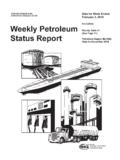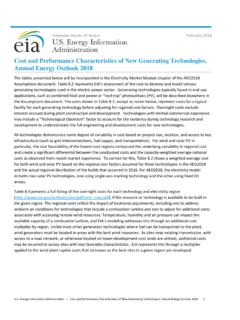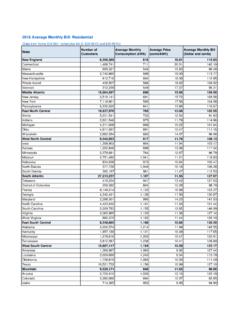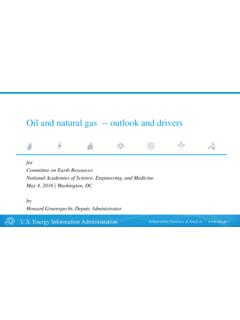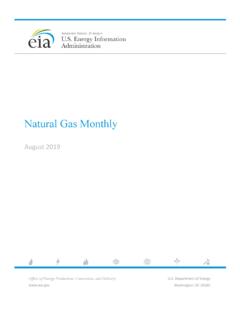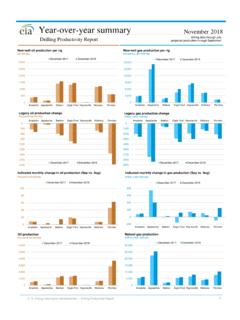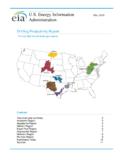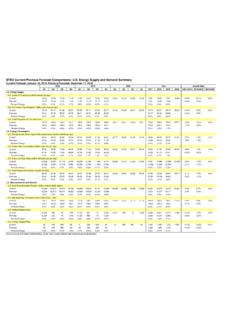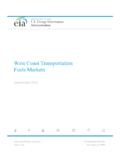Transcription of World Oil Transit Chokepoints
1 1 World Oil Transit Chokepoints Last Updated: July 25, 2017 Overview World Chokepoints for maritime Transit of oil are a critical part of global energy security. About 61% of the World 's petroleum and other liquids production moved on maritime routes in 2015. The Strait of Hormuz and the Strait of malacca are the World 's most important strategic Chokepoints by volume of oil Transit . The energy information administration (EIA) defines World oil Chokepoints as narrow channels along widely used global sea routes, some so narrow that restrictions are placed on the size of the vessel that can navigate through them.
2 Chokepoints are a critical part of global energy security because of the high volume of petroleum and other liquids transported through their narrow straits. In 2015, total World petroleum and other liquids supply was about million barrels per day (b/d).1 EIA estimates that about 61% that amount ( million b/d) traveled via seaborne Oil tankers accounted for almost 28% of the World s shipping by deadweight tonnage in 2016, according to data from the United Nations Conference on Trade and Development (UNCTAD), having fallen steadily from 50% in International energy markets depend on reliable transport routes.
3 Blocking a chokepoint, even temporarily, can lead to substantial increases in total energy costs and World energy prices. Chokepoints also leave oil tankers vulnerable to theft from pirates, terrorist attacks, political unrest in the form of wars or hostilities, and shipping accidents that can lead to disastrous oil spills. The seven Chokepoints highlighted in this report are part of major trade routes for global seaborne oil transportation. Disruptions to these routes could affect oil prices and add thousands of miles of Transit in alternative routes.
4 By volume of oil Transit , the Strait of Hormuz, leading out of the Persian Gulf, and the Strait of malacca (linking the Indian and Pacific Oceans) are the World 's most important strategic Chokepoints . This report also discusses the role of the Cape of Good Hope, which is not a chokepoint but is a major trade route and potential alternate route to certain Chokepoints . 2 Figure 1. Daily Transit volumes through World maritime oil Chokepoints All estimates in million barrels per day. Includes crude oil and petroleum liquids.
5 Based on 2016 data. Source: energy information administration Table 1. Volume of crude oil and petroleum liquids transported through World Chokepoints and the Cape of Good Hope, 2011-16 (million barrels per day) Location 2011 2012 2013 2014 2015 2016 Strait of Hormuz Strait of malacca Suez Canal and SUMED Pipeline Bab el-Mandeb Danish Straits Turkish Straits
6 Panama Canal Cape of Good Hope World maritime oil trade n/a World total oil supply Note: Data for Panama Canal are by fiscal year. Sources: energy information administration analysis based on Lloyd's List Intelligence, Panama Canal Authority, Argus FSU, Global Trade Tracker, BP Statistical Review of World energy , IHS Waterborne, Oil and Gas Journal, Suez Canal Authority, and UNCTAD, using EIA conversion factors 4 3 Oil tanker sizes Ships carrying crude oil and petroleum products are limited by size restrictions imposed by maritime oil Chokepoints .
7 The global crude oil and refined product tanker fleet uses a classification system to standardize contract terms, to establish shipping costs, and to classify vessels for chartering contracts. This system, known as the Average Freight Rate Assessment (AFRA) system, was established by Royal Dutch Shell six decades ago, and the London Tanker Brokers' Panel (LTBP), an independent group of shipping brokers, oversees the system. AFRA uses a scale that classifies tanker vessels according to deadweight tons a measure of a ship's capacity to carry cargo.
8 The approximate capacity of a ship in barrels is determined using an estimated 90% of a ship's deadweight tonnage, which is multiplied by a barrel-per-metric-ton conversion factor specific to each type of petroleum product and crude oil, as liquid fuel densities vary by type and grade. Figure 2. Average Freight Rate Assessment (AFRA) Scale-Fixed Source: energy information administration , London Tanker Brokers' Panel5 Note: AFRAMAX is not an official vessel classification on the AFRA scale but is shown here for comparison. The smaller vessels on the AFRA scale the General Purpose (GP) and Medium Range (MR) tankers are commonly used to transport cargos of refined petroleum products over relatively shorter distances, such as from 4 Europe to the East Coast.
9 Their smaller size allows them to access most ports around the globe. A GP tanker can carry between 70,000 barrels and 190,000 barrels of motor gasoline ( million gallons), and an MR tanker can carry between 190,000 barrels and 345,000 barrels of motor gasoline ( million gallons). Long Range (LR) class ships are the most common ships in the global tanker fleet, as they are used to carry both refined products and crude oil. These ships can access most large ports that ship crude oil and petroleum products. An LR1 tanker can carry between 345,000 barrels and 615,000 barrels of gasoline ( million gallons) or between 310,000 barrels and 550,000 barrels of light sweet crude oil.
10 A large portion of the global tanker fleet is classified as AFRAMAX. AFRAMAX vessels are ships between 80,000 deadweight tons and 120,000 deadweight tons. This ship size is popular with oil companies for logistical purposes, and many ships have been built within these specifications. Because the AFRAMAX range exists somewhere between the LR1 and LR2 AFRA scales, the LTBP does not publish a freight assessment specifically for AFRAMAX vessels. Over the history of AFRA, vessels grew in size, and newer classifications were added. The Very Large Crude Carrier (VLCC) and Ultra-Large Crude Carrier (ULCC) were added as the global oil trade expanded and larger vessels provided better economics for crude oil shipments.
